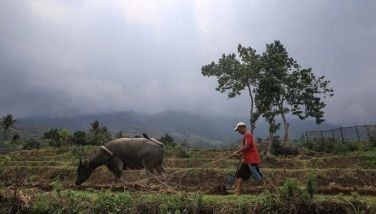Donations continue to pour in
MANILA, Philippines - Donations continue to pour in for the thousands of families displaced by the widespread monsoon floods in Metro Manila and nearby provinces, the National Disaster Risk Reduction and Management Council (NDRRMC) said yesterday.
NDRRMC director Armando Duque said the donations came mostly in the form of relief goods, foodstuff, bottled drinking water, and medicine.
“These donations are now being received, handled and distributed to the flood victims in the affected areas of Metro Manila and nearby provinces by various line agencies like the Department of Social Welfare and Development (DSWD), Department of Health (DOH), and non-government groups,” Duque said.
The Armed Forces of the Philippines (AFP) and the Philippine National Police (PNP), as well as personnel from the Philippine Coast Guard (PCG), are also on hand to assist the affected residents, Duque said.
“Local and foreign donations continue to pour in as we shift from search and rescue missions to relief distribution and rehabilitation operations. So many donations are coming in,” he said.
The United Nations World Food Programme (WFP) has mobilized logistics and food support to complement the Philippine government’s emergency relief efforts.
The WFP has delivered a total of 52.5 metric tons of high-energy biscuits to 262,500 flood-affected people in Metro Manila and Regions III and IV-A, and the DSWD is currently distributing them to the affected areas.
Most of the biscuits (39.5 metric tons) will go to Regions III and IV-A, which the government has identified as the most flood-affected, where they will be distributed to 197,500 people.
The remaining 13 metric tons will assist 65,000 flood-affected people in the National Capital Region, which includes Manila, Marikina, Muntinlupa, Parañaque and Quezon City.
High-energy biscuits are wheat-based biscuits fortified with vitamins and minerals. They are often distributed during the first few days of an emergency, when people have limited access to cooking facilities.
In addition to distributing the biscuits, the WFP is contracting trucks to help the DSWD transport relief supplies to affected communities in Metro Manila and neighboring provinces.
The WFP is also planning to distribute nutritious, ready-to-use supplementary food to about 77,000 flood-affected children aged six to 36 months in Luzon, in partnership with the DOH.
“The WFP is saddened by the humanitarian impact of the non-stop rains over the last week in the Philippines, and we would like reiterate our solidarity with the Philippine government during times of emergencies. We stand ready to offer our full support to augment government efforts when needed,” said WFP Philippines representative and country director Stephen Anderson.
Australia also announced it will send donations for the flood victims.
Australian Minister for Foreign Affairs Bob Carr said they would be making available up to A$2 million (P88 million) in food and emergency supplies, to be delivered through the Philippine Red Cross (PRC) and the WFP.
The Australian government has provided P44 million worth of emergency kits for distribution to families which include medical supplies, mosquito nets and water containers, and another 1,000 tons of rice worth P44 million.
“We are providing $1 million to WFP and we are backing that up with nearly $1 million made available to the Red Cross for those in need,” Carr said.
“The Australian government has made these items available through the PRC and WFP so that they can be immediately accessed in serious humanitarian situations, such as the current flooding in and around the capital,” said Australian Ambassador Bill Tweddell.
“We know that prompt response is essential to saving lives during disasters. Australia, through our arrangements with the PRC and WFP, is able to assist the Philippine government to respond quickly and effectively,” Tweddell said.
Officials of the Australian Agency for International Development (AusAID) visited flood-affected areas.
They have been working closely with the government and other donors to ensure the Philippines would get the support it needs to manage the crisis.
The volunteer network Tulong Kabataan (TK) of 5,000 volunteers also launched relief operations in affected areas in Metro Manila.
“We know that everyone wants to help out others in these times of great need; some people just might have trouble getting to relief centers or even finding the actual relief centers so TK goes to the people instead,” TK national coordinator Vencer Crisostomo said.
So far, TK services such as feeding programs, medical missions, and relief distribution have reached 5,000 people in hard-hit, seldom reached areas such as Baseco compound in Manila, Commonwealth, Batasan, East Kamias in Quezon City, and Catmon in Malabon.
Evacuees up north increasing
While the number of evacuees in Metro Manila has significantly decreased, except in the flood-prone cities of Marikina and Pasig, Duque noted a significant increase in the total number of evacuation centers set up in Central Luzon to accommodate more families displaced by the flooding in Pampanga and Tarlac.
“Flooding worsened Friday in Tarlac due to continuous heavy southwest monsoon rains. This is where there is concentrated cloud formation,” Duque said. – Pia Lee Brago, Sandy Araneta, Marvin Sy
- Latest
- Trending

































